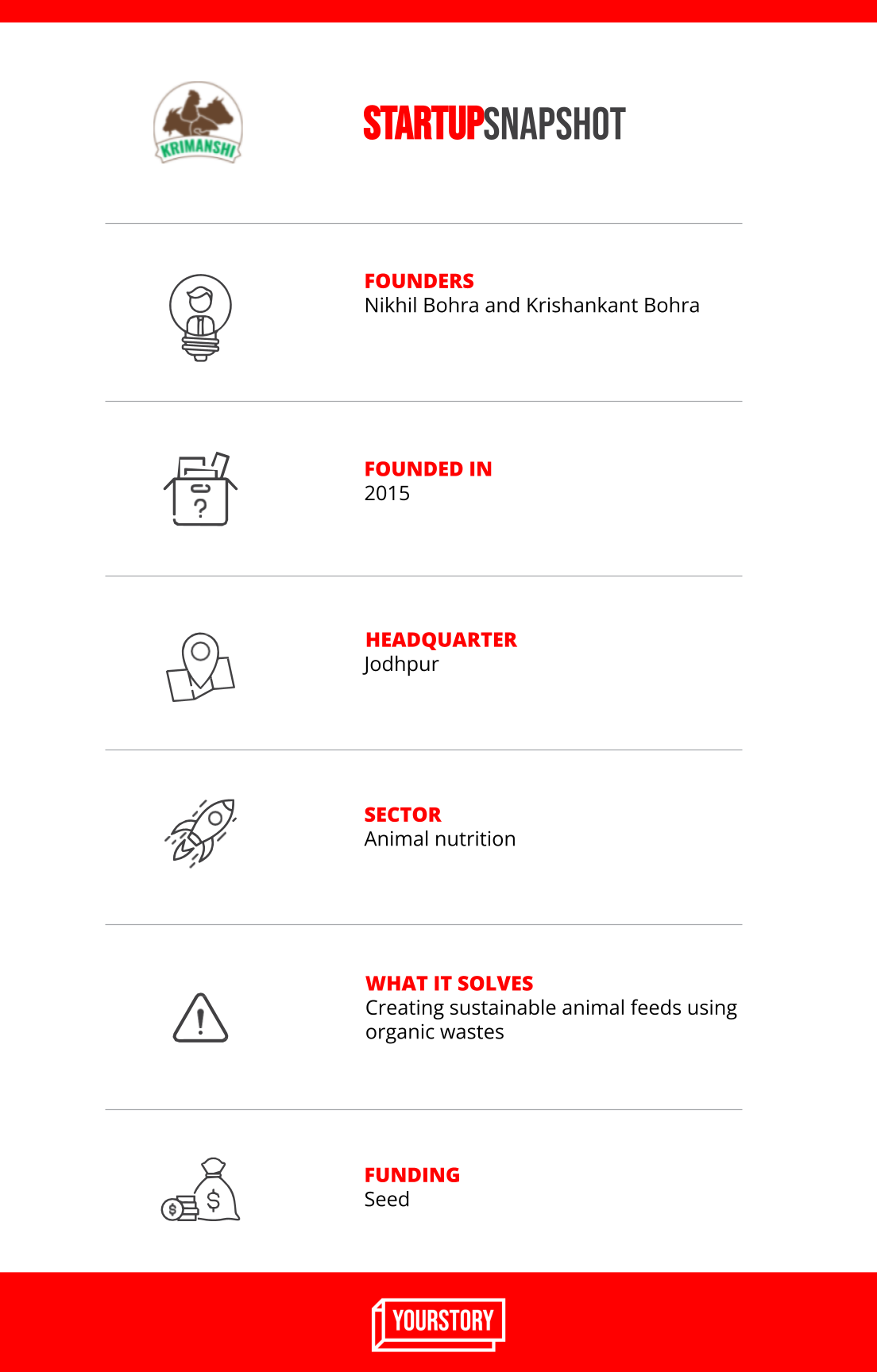Many animal-feed brands in India, in an effort to generate maximum profits, fall into the vicious pit of manufacturing adulterated animal feed. In dairy cattle, sheep and goats, chronic exposure to the adulterants can reduce milk production, impair reproduction and liver function, compromise immune function, and increase susceptibility to diseases.
“These adulterants can contaminate a variety of livestock feeds and cause enormous economic losses, posing significant hazards on consumers’ health and rural livelihoods,” says Nikhil Bohra, Founder and CEO of a Jodhpur-based animal nutrition startup, Krimanshi Technologies Pvt Ltd.
Founded in 2015 by Nikhil and his father Krishankant Bohra, Krimanshi manufactures nutritious climate resilient animal feeds based on alternate fibres, proteins and fats derived from upcycling of organic food waste and agri residues. The startup has the capacity to upcycle upto 30 tons of food waste per day into feed ingredients and balanced compound feeds for livestock, according to Nikhil.

“Due to the growing population and developing industries, relying only on traditional sources such as soya bean meal and fishmeal would make the sources scarce and expensive in the near future. Therefore, it seems indispensable to consider alternative protein and fiber sources to replace the conventional sources in dairy and poultry feed,” explains Nikhil.
According to a World Bank report, global food waste is expected to reach 3.40 billion tonnes by 2050. It further reveals that approximately 60 percent of urban solid waste in India is organic, consisting of vegetable, food and other debris. Bengaluru alone sees about 3,000 tonnes of organic waste is generated every day.
“Rotting organic waste emits methane, which is 23 times as potent as carbon dioxide as a greenhouse gas. The irony is that these resources are seldom upcycled and do not find any further use,” Nikhil says.
“We want to solve these issues of adulteration in food, finding alternative protein and fiber sources, and urban organic waste via a single solution by collecting and converting food waste into sustainable insect proteins,” he adds.
The team
Nikhil is a biotech engineer from VIT Vellore. He led Krimanshi to win the Animal Husbandry Grand Challenge 2020 organised by the Department of Animal Husbandry and Fisheries, Government of India. He has worked for donor projects under JICA (Japan International Cooperation Agency), World Bank and EU on WASH (water, agriculture, sanitation and health), environment and nutrition projects and led the India operation of WaterWello - USA in the past. He currently leads R&D, product development, partnerships, and fundraising at Krimanshi.
Nikhil’s father Krishankant, who is Co-founder and COO of the company, has researched organic and inorganic chemical product formulations for food, cement and mineral industries. He has over 30 years of experience working in chemical testing, production and project management and brings his expertise in quality control in food, cattle feed, minerals, cement, and chemical production. At Krimanshi, he oversees overall production processes.
With their joint interest in food, biotech and chemistry, the duo come together to start Krimanshi, which hasabout 25 employees currently.
“My belief in ‘Let food be thy medicine and thy medicine shall be thy food’ is our driving force behind Krimanshi to create sustainable animal feeds business,” says Nikhil.
The differentiation
As per Nikhil, today, a large part of food waste under MSW (municipal solid waste) is either converted to manure, biomethane or dumped. “Conversion of organic waste into biomethane and manure is not sustainable as 1) waste generators seldom give the tipping fee to take away the waste, 2) producing biomethane is a costly affair and price realisation is often difficult, while the manure formed competes with subsidised urea fertilisers. Converting food waste to animal feed makes more sense because of the established ready to sell market, better price realisation, and additional farmer and environmental benefits,” says Nikhil.
“We are building our own greener feed ingredient supply chain which gives an edge for feed formulations. This also helps have a larger buffer to absorb price fluctuations in commodity markets while still providing the best quality feeds to livestock farmers,” he adds.
Krimanshi is trying to make the entire processes efficient and bring down the cost of insect meal below the price of fish meal to make it a viable option, forcing millers to move away from fish meal, which is one of the largest contributors to carbon emission and can be easily avoided.
Insect meal is insects being used as an alternative protein source for poultry and aqua industries. Insects are either fed as a whole or processed such as in powdery form, either fed as fresh or dried. Fish meal is a commercial product made from whole wild-caught fish, bycatch and fish by-products to feed farm animals, e.g., pigs, poultry, and farmed fish.
“Unlike the conventional feed varieties - whose production is weather-dependent - we are moving towards climate resilient, balanced feed products that are available to livestock farmers all year round,” Nikhil says.
Challenges along the way
“Raising capital and establishing an organic food waste supply chain as raw materials are our biggest challenges that we need to overcome in order to scale,” admits Nikhil. “As feed tech is still in its nascent stage, we need patient investment to help us build this feed stack faster and better.”
“To keep pace with our production targets, we need to keep adding partners who can generate organic food wastes , and they could be anything from APMCs (agricultural produce market committees) to food/ agro processing industries,” Nikhil reveals.

Bridging the present and future
According to a report by ResearchAndMarkets.com, the Indian animal feed market was worth Rs 348 billion in 2017. The market is further projected to reach Rs 788 billion by 2023, at a CAGR of 14.5 percent during 2018-2023. The insect protein market is projected to reach $1,336 million by 2025, from $144 million in 2019, at a CAGR of 45.0 percent during the forecast period, as per MarketsandMarkets.
“India’s feed mills have the capacity to produce 2.88 million metric tons of feed. We are present in Rajasthan and Karnataka, which is a Rs 2300 crore feed market, and working with 250+ retailers and a network of (farmer producer organisations) FPOs and social enterprises to serve dairy farmers,” Nikhil says.
Currently, Krimanshi’s presence in the Western districts of Rajasthan enables it to cater to its markets. The startup is working with 250+ distributors/retailers and a network of FPOs and social enterprises in Jodhpur, Jaipur, Alwar, Dholpur, Ajmer, Pali, Nagaur, Bhilwara and Barmer districts of Rajasthan, and Patan and Banaskantha districts of Gujarat covering over 5,000 farmers and serving around 20,000 cattle heads.
“Our farmers have witnessed up to 20 percent increase in milk production, saving 10 percent on feed costs, and earning up to Rs 60/cow/day with 60 percent reduction in veterinary costs. We work majorly on the B2B2C model, supplying feeds to livestock farmers via rural micro entrepreneurs or rural shops,” Nikhil says.
“In phase 2, we are launching aqua and poultry feed. We aim to open animal nutrition centres in all the areas where we would provide feed, RM, supplements and veterinary products, becoming a one stop solution for all their veterinary needs,” Nikhil adds.
The startup has raised more than Rs 6 crore in funding till date. It generates revenue by selling cattle feeds to dairy farms through retailers, FPOs and social enterprises.
In the next three years, Krimanshi hopes to forge partnerships with various food processing industries to convert their food wastes into animal feeds and reach a production capacity of 5000 TPM (total productive maintenance) serving 1 million+ livestock month on month.
“Sticking to our mission of climate resilient feeds, we also aim to launch our bacterial and algae feeds which are yet under R&D,” says Nikhil. Krimanshi competes with the likes of traditional feed manufacturers and distributors.
Edited by Anju Narayanan

